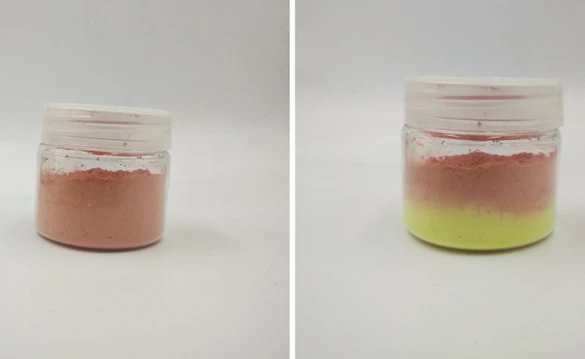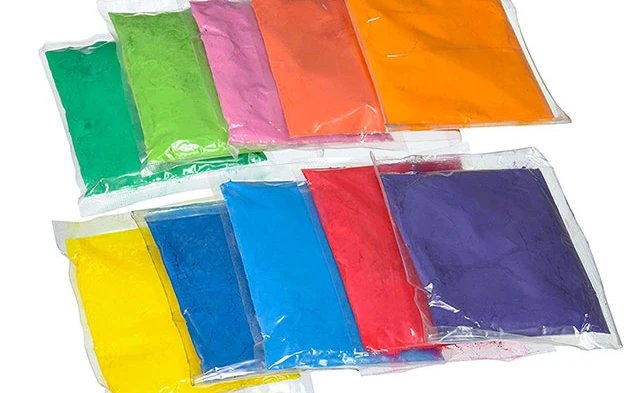Thermochromic pigments are state-of-the-art products but structurally weak compared with many other pigments and dyes. To take full advantage of this product while keeping it out of harm’s way, the following precautions are to be observed in the application of thermochromic pigments.
I. Effect of thermochromic pigments Temperature
Thermochromic pigments usually change colors within a certain temperature range, while in a setting beyond that range thermochromic pigments might not achieve color change as expected or unsatisfactory color change results. Therefore, it’s necessary to understand and confirm the proper temperature range that fits the thermochromic pigments being used. In addition, ambient temperature also affects the color change results of thermochromic pigments for excessively high or low ambient temperature might result in improper color change. So the application of thermochromic pigments in suitable ambient temperature is strongly advised.

II. Thermochromic pigments Dosage
We recommend using 2% to 5% thermochromic powder in resin or plastic castings. When using thermochromic powder, if the material is already colored, we recommend adding no more than 2.5%. Also note that improper use of plastic fillers may cover the color of thermochromic pigments. Thermochromic powder is used in printing inks and coatings in an amount of 8%-12%.
III. Thermochromic pigments Mixing and Friction
Thermochromic pigment microcapsules are susceptible to mechanical damage when mixed with materials. Hence friction must be reduced in the preparation of such pigment before it’s employed. We recommend using a slow speed mixer, hand mixing, a three-roll mill or other “gentle” mixing method. Using a high-speed agitator such as a ball mill will quickly destroy the microcapsule structure of the calorific value color-changing pigment.. Besides, In addition, we should consider adding dispersants during mixing to prevent repeated extrusion and shorten the mixing time.
IV. Thermochromic pigment Mediums Requirements
Due to the thin wall of thermochromic pigment microcapsules, do not use solvents containing three or fewer carbon atoms, such as methanol, ethanol or acetone, because these small particles can easily penetrate the microcapsule wall and destroy the pigment structure, causing color deformation or pigment fading, resulting in colour deformation or pigment discoloration. We use solvents adapted to select solvents containing particles with six or more carbon atoms.

If we must use small particle solvents, we should control the amount used. The solvent will quickly evaporate after being sprayed and printed, and won’t leave damage to pigments.
Let’s take a look at the effects of different solvents on thermochromic powders. The data shows time needed to form visible deformations in pigment performance (at 20°C). It’s to be noted that only pure solvents were used for this experiment, and usually in mediums are mixed with solvents, binders, emulsifiers and other compounds which may react with thermochromic pigments, therefore this table is for reference only.
| Methanol | DMF | Ethanol | Acetone | Ethanol 40% | Isopropyl alcohol | Ethyl acetate | Ethylene glycol/diethyl ether | Butyl acetate | Butanone |
| Up to 5 hours | Up to 48 days | Up to 48 days | 1/3-2 months | 2/3-3 months | 30-180 days | 60-150 days | 90-300 days | 90-300 days | 90-180 days |
| Water (pH 2-8) | Toluene | Cyclohexanone | Benzyl alcohol | Gasoline | Mineral oil | Turpentine | Plasticizer DOP | Xylene | Cyclohexane |
| Over 3 Years | Over 1 Years | Over 1 Years | Over 1 Years | Over 1 Years | Over 1 Years | Over 1 Years | Over 1 Years | Over 1 Years | Over 1 Years |
Before using thermochromic powder, make sure there are no small particles of solvent in the ring. Even a small amount can damage the pigment. So tests are suggested before a new medium is put into use.
V. UV resistance
Thermochromic pigments have low UV resistance. When we use thermochromic pigments for coloring, the surface of the product needs to be coated with a layer of UV protection paint. For outdoor products, it is mandatory. Pigments may be added to UV hardened resins (duration of hardening is short), so UV light won’t damage pigments within the range of visible light.
VI. Thermochromic Pigments Water-based Mediums
Thermochromic pigments can be added to water-based paints and inks. As it is mentioned above mediums shall not contain solvents with particles having less than 4 atoms of carbon. The Medium pH should remain at 2-8 (optimally 2.5-5). In alkaline media with a pH value above 8, thermochromic pigments will eventually be damaged.. Addition of a few nonionic surfactant will help thermochromic pigments disperse in mediums more easily.
VII. Thermochromic Pigments for Inks and Paints
When the temperature is above a certain level, they become transparent. The index of refraction of thermochromic pigment microcapsules is 1.5-1.54, and if binders used in paint/ink showcase significant difference in the index of refraction, then we will see “fog” effect instead of translucent layers after the color changing temperature is reached. Generally speaking, thermochromic pigments go well with alkyd and acrylic resins while don’t make good partners with polyamide resins and cellulose nitrate.

Differences in the index of refraction have also some impact on the choice of solvents. Solvents like toluene, xylene and benzene methanol (the indexes of refraction are 1.496, 1.493 and 1.54 respectively) have similar index of refraction as thermochromic pigments and work well with them. But if we use isobutyl alcohol with significantly different index of refraction (1.377), then we will observe smaller colour concentration than the actual one. But this effect is reversible, and the color returns to normal after the solvent evaporates..
Pigment microcapsules act like clear glass. Regular thin glass are transparent, but glass as thick as 100mm has green colour. If we want a completely transparent surface, we can apply a layer of thermochromic material on it. When pigments are already colored, it’s enough to have patterns on the surface covered.
Phosphates, bromides and chlorides will damage the calorific value color pigments and should not be present in the rings.
VIII. Possible Effects of Thermochromic Pigments
After reaching desired temperature, thermochromic pigments will become transparent. Pigments below this temperature will witness color mixing that might generate four effects:
Thin-layer pigments (such as paints or inks) become transparent after reaching the specified temperature. Patterns beneath the pigment layer will be revealed.
When used on thicker objects (such as resin castings), the pigment will turn white after reaching the specified temperature, and the refraction of thousands of microcapsules creates an effect similar to dense fog.
Pigments can also be colored with other dyes or pigments; it’s crucial to use them correctly to prevent the second coloring agent from obscuring the effect of thermochromic pigments. For instance, if we dye resin with green transparent dye and add red thermochromic pigments that will change color at 30°C. According to color blending rules, the resin, when below 26.5°C (at which the red pigment begins to fade), will appear yellow. As the temperature rises from 26.5°C to 30°C, the resin will shift from yellow to green, returning to its original green color at 30°C.
Using several different thermochromic pigments (different colors and color changing temperatures) makes the availability of products possible with several different colors as the temperature changes.
IX. Storage of Pigment and Thermochromic Products
Thermochromic pigments are sensitive to UV light, so it’s important to keep it from direct sunlight and stored in shades. Finished thermochromic products should be coated with UV-resistant paint, and this is particularly important for those often exposed to direct sunlight.
Thermochromic pigments can alter colors beyond the limit of attempt without significantly altering their performance. So pigments and products containing them should be stored in an environment several Celsius degrees below the color changing temperature (for example, pigments that change color at 30°C begin to fade at 26.5°C, so storing them at 24°C or lower is safe). It’s to be noted that freezing will also damage thermochromic pigments.
X. Six issues when using thermochromic pigments
1. Is Thermochromic pigment powder toxic?
Nowadays, the prosperous maternal and infant market is followed by quality problems of maternal and infant products. People are becoming increasing concerned about them. In recent years, many manufacturers of maternal and infant products have developed a lot of new products to attract customers, including thermal feeding bottle, thermal clothes, and thermal nipple. Mothers feel worried about these products and think these products may be toxic, so that they dare not buy these products. Is thermal pigment powder safe?
Such thermal pigment powder is environmentally friendly and nontoxic, and manufacturers also provide test reports. Besides, parents can easily see the current temperature of the feeding bottle. The existing feeding bottle can indicate temperature. This utility model improves the setting of temperature indicator on the existing feeding bottle and expands the effective application.
2. What should I be aware of when using a curing agent with warm thermochromic pigment powders?
The thermochromic pigment powders is prepared by using electron-transfer type organic compound system. Due to electron transfer at certain temperatures, the molecular structure of such organic compounds changes, thus causing color change. We usually need to add some curing agent or cross-linking agent during injection molding. In this case, what should we pay attention to?
The type of curing agent is closely related to the mechanical properties, heat resistance, water resistance, and corrosion resistance of the curing agent. During the cross-linking and curing of epoxy resin and unsaturated polyester resin, great shrinkage stress may sometimes be generated from inside, causing the shell of thermochromic pigment powders microcapsule to break. As a result, other chemical substances will go into the thermochromic pigment powders, making them lose color-changing properties. This is often the case when the curing thickness of epoxy resin is more than 0.2mm and polyamine curing agent is used. We should pay attention to the following matters:
Light resistance:
Thermochromic pigment powder has poor light resistance. It will fade and lose efficacy quickly when exposed to strong sunlight. Therefore, it is only suitable for use in indoor environment. It should avoid exposure to strong sunlight and UV lamp light, so as to extend the service life of thermochromic pigment powders.
Heat resistance:
Thermochromic pigment powder is able to resist high temperature of 230℃ for a short period (about 10 min). Therefore, it can be used for injection molding and high-temperature curing. thermochromic pigment has different thermal stability in chromatic state and achromatic state. The thermal stability of thermochromic pigment powders in chromatic state is higher than that in achromatic state. Besides, when the temperature is above 80℃, organic substances that constitute the color-changing system will begin to degrade. Therefore, we should avoid the use of thermochromic pigment powders above 75℃ for a long time.
3. Why is the color uneven when mixing thermochromic pigment products?
Thermochromic pigment products can be used on many materials, such as silk screen printing of cloth and handicrafts (through injection). The thermal powder can also be used for injection molding of transparent or translucent plastic such as polypropylene (PP), soft PVC (S-PVC) and silica gel. They can also be mixed with unsaturated polyester and epoxy resin. Some customers mix thermal powder with crystal glue for color matching, but the color becomes uneven after drying. Why?
There are many reasons for uneven color after crystal glue is mixed with the thermochromic pigment products. First, it has nothing to do with the quality of the thermal powder because color matching does not rely on the quality of the thermal powder. If the thermochromic pigment products cake, it may cause uneven color matching. There is another reason. During the process of color matching, you fail to stir the crystal glue in the same direction. As a result, the thermochromic pigment products are distributed unevenly.
Solutions for such problems:
Mash up caked thermochromic pigment products;
Stir the crystal glue and at the same time pour thermochromic pigment products into it;
Always stir it in the same direction and never change the direction.
4. Will the brightness be affected by mixing temperature color change pigment with other color powders?
The color of temperature color change pigment changes with temperature, while the color of other pigment powder remains unchanged. If we mix temperature color change pigment with other pigment powder, will the effect of color change be influenced?
Generally, the color changing effect of temperature color change pigment will be influenced when it is mixed with other pigment powders. The specific degree of influence on luminance depends on the mixing ratio and the color selection.
5. Does thermochromic powder release toxic substances when exposed to high temperatures?
The thermochromic powder is a very special printing material as well as a color-changing pigment which changes color with temperature changes. The color will change from one color to no color at certain temperature. The longer temperature lasts for, the longer color change will maintain. When the temperature drops, it will return to original color. Someone may ask a question: will the thermochromic powder release toxic substances at high temperature?
Thermochromic powder pigment is prepared by using electron-transfer type organic compound system. Electron-transfer organic compound is a kind of organic chromogenic system with special chemical structure. Due to electron transfer at certain temperature, the molecular structure of such organic compound changes, thus causing color change.
Generally, the range of temperature for the use of thermochromic pigment powder falls between room temperature and 200℃. The specific range of temperature may vary with the brand and model. We recommend that you refer to the product instructions or the manufacturer’s suggestions before use.
Thermochromic powder contains a kind of color-changing substance inside and is wrapped with a layer of transparent shell with a thickness of around 0.2-0.5μm, which can neither dissolve nor melt. The shell does not contain any toxic substance, nor will it release any toxic substance, which meets the packing specification for safe toys and food. Customers can use kingchroma thermochromic powder without any worry.
6. Can thermochromic pigment powder be exposed to the sun?
Can we use thermochromic pigment powder in outdoor environment? Will its function and effect be influenced when it is exposed to strong sunlight?
Thermochromic pigment powder is a kind of material that changes its color as the temperature changes. Generally, it can be used in indoor environments. Exposure to strong sunlight may cause the thermochromic pigment powder to lose the effect of color change or to fade. For this reason, we do not recommend long time exposure to sunlight.
Continue Reading
Pignmet for Thermochromic Paint
How to Use Thermochromic Paint for Cars?
The Wonders of Thermal Color Changing Paint (5 Main Applications)



